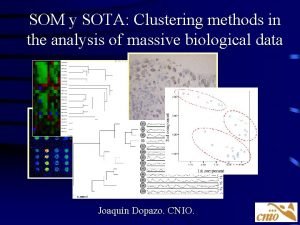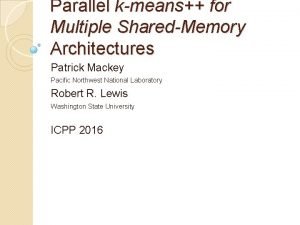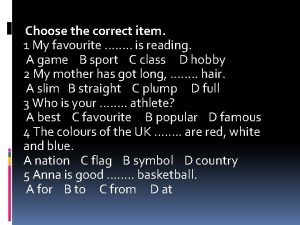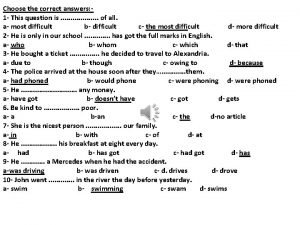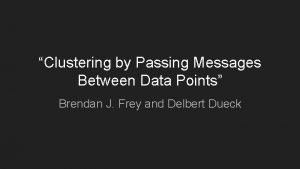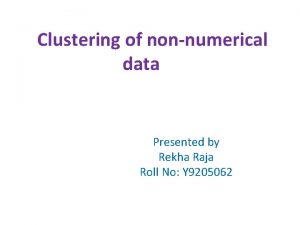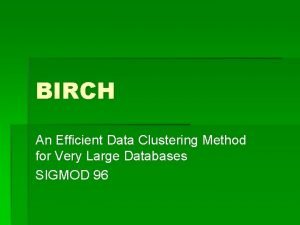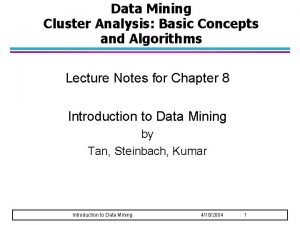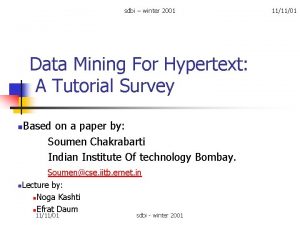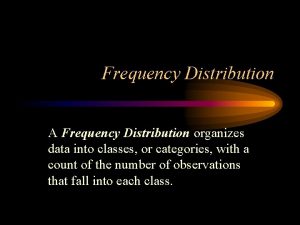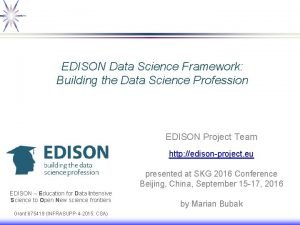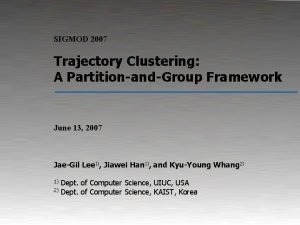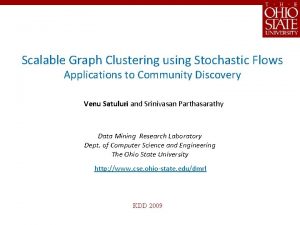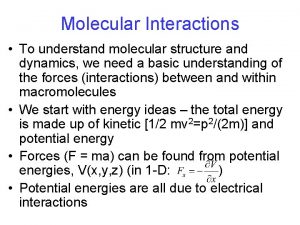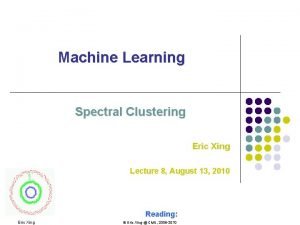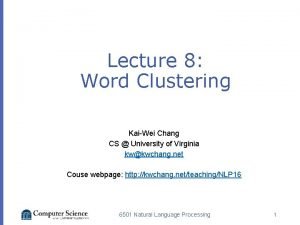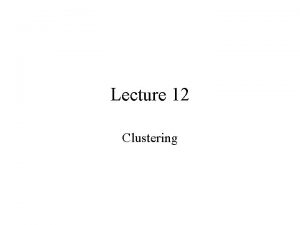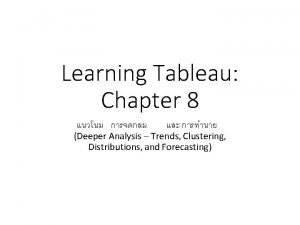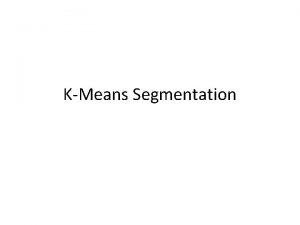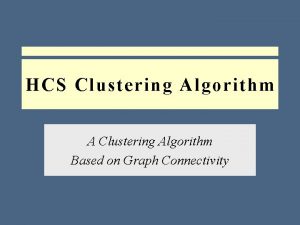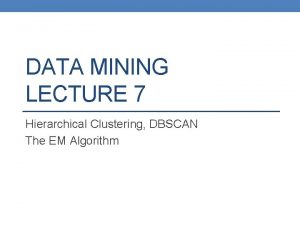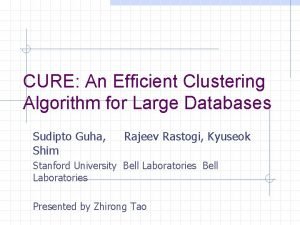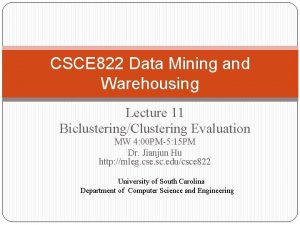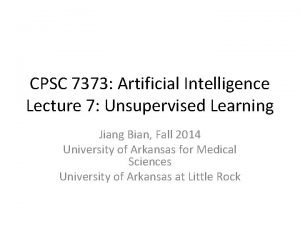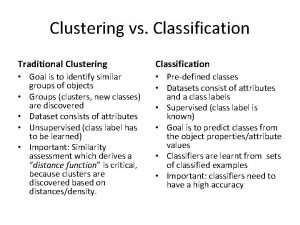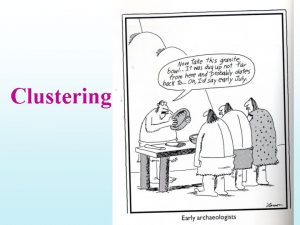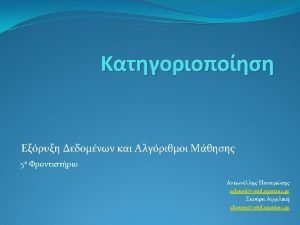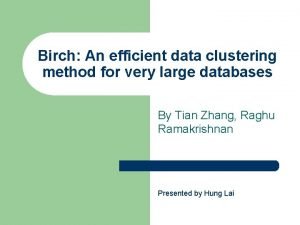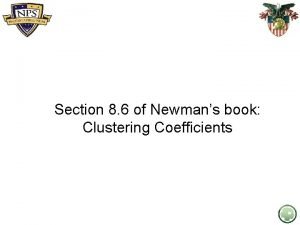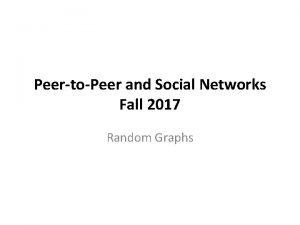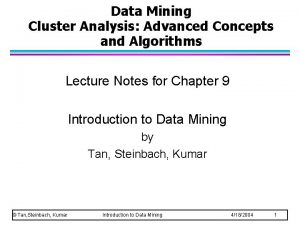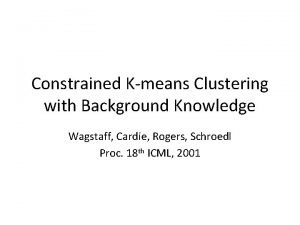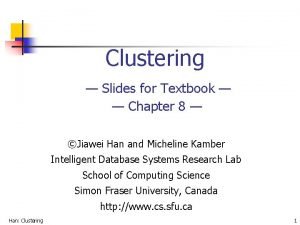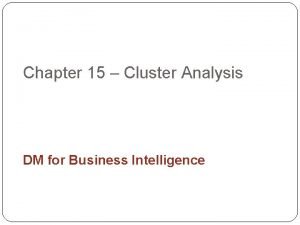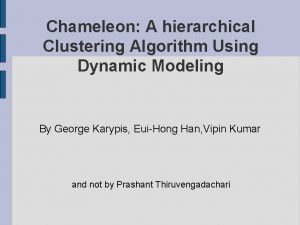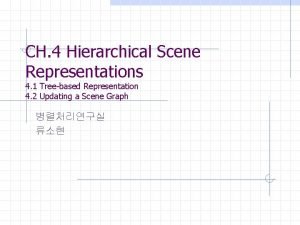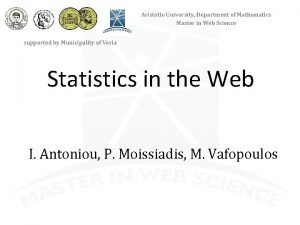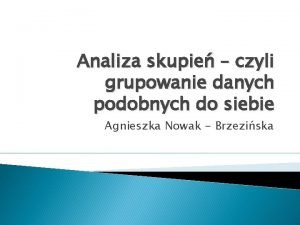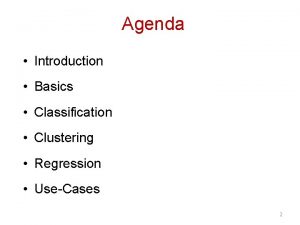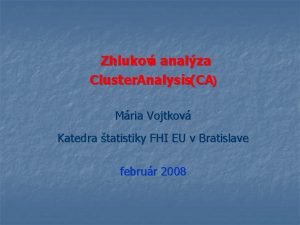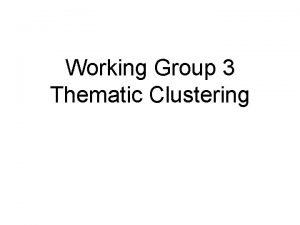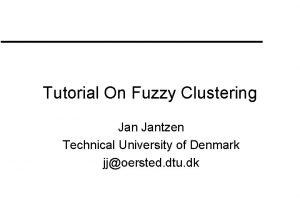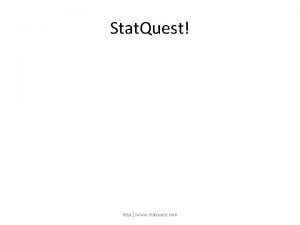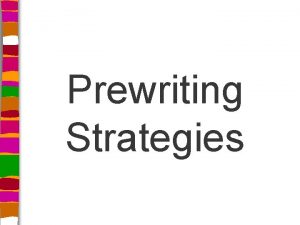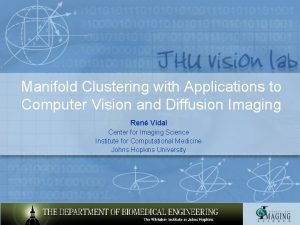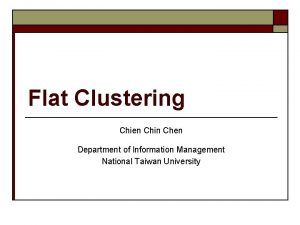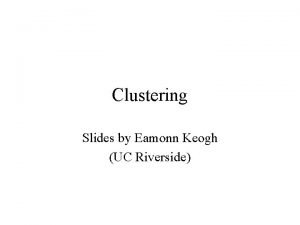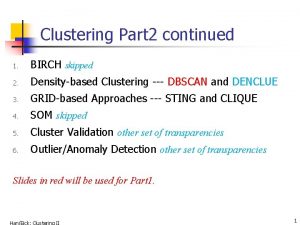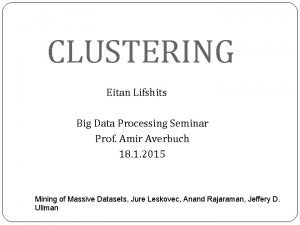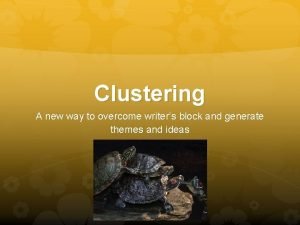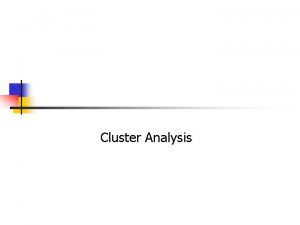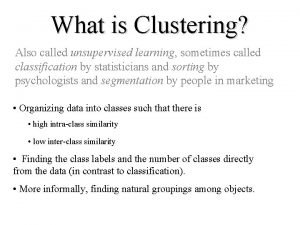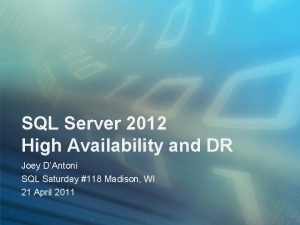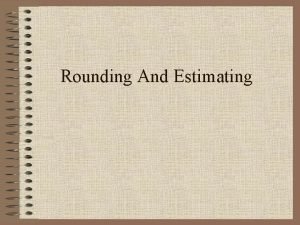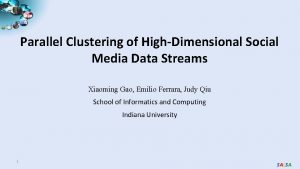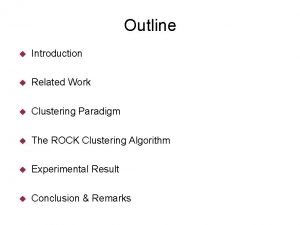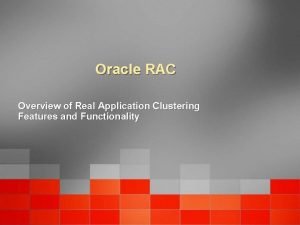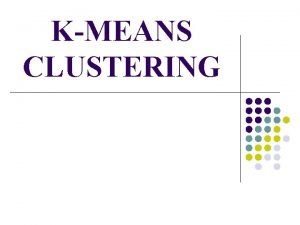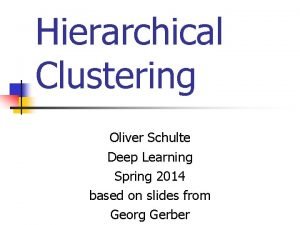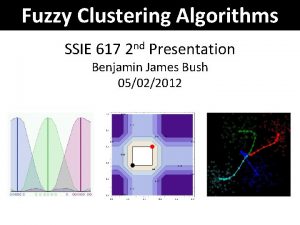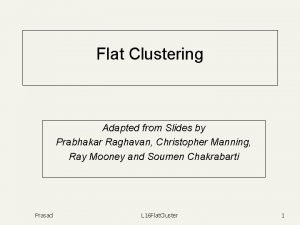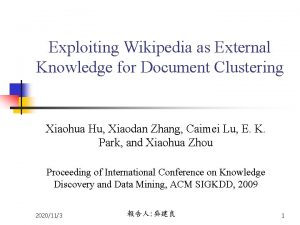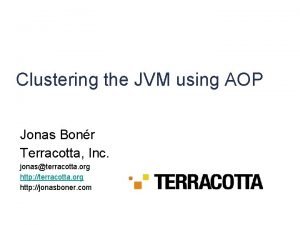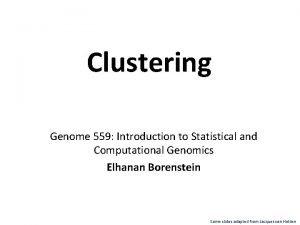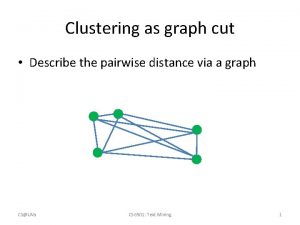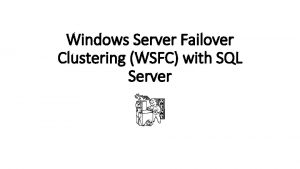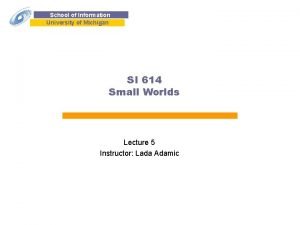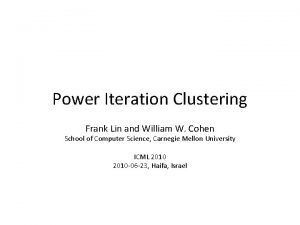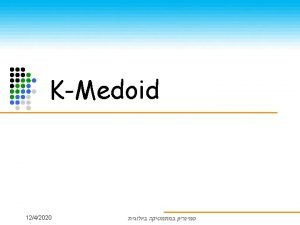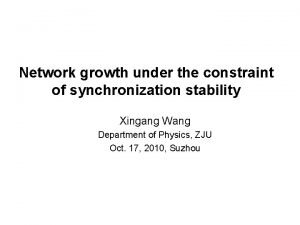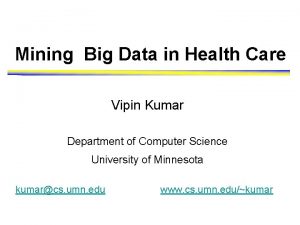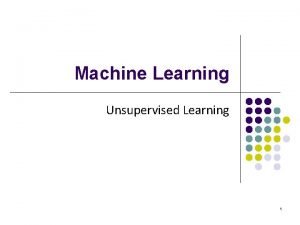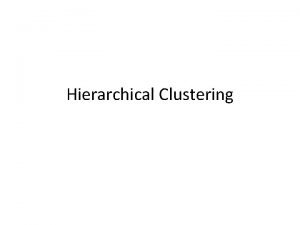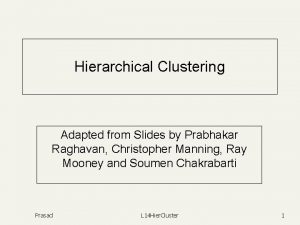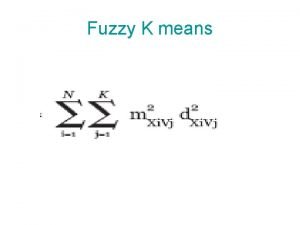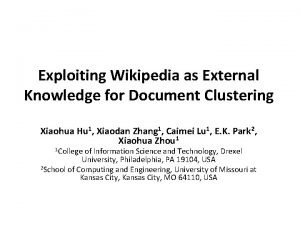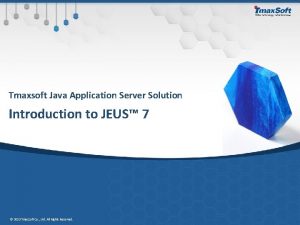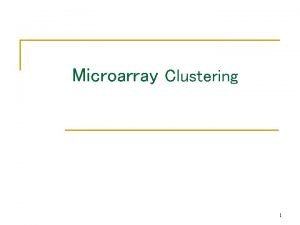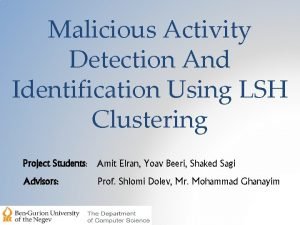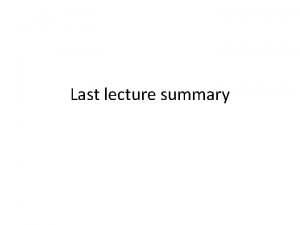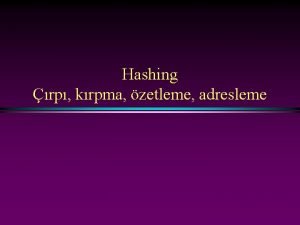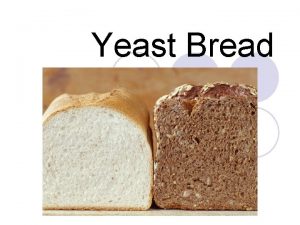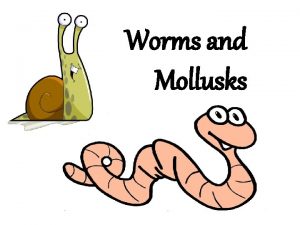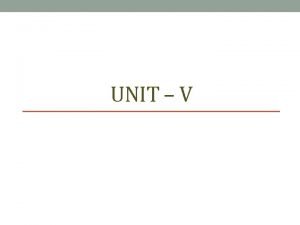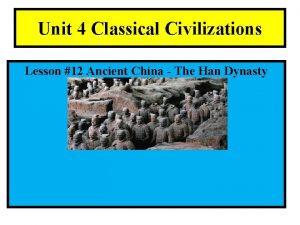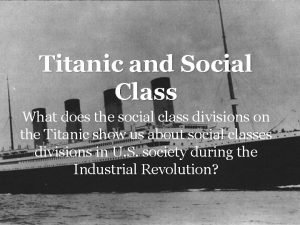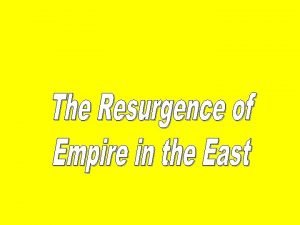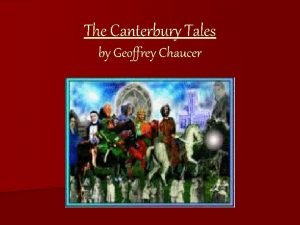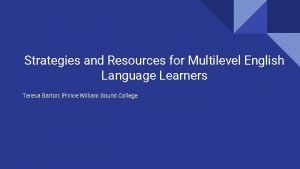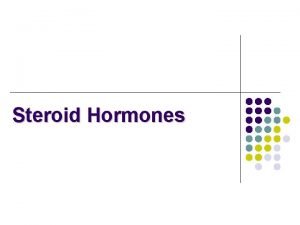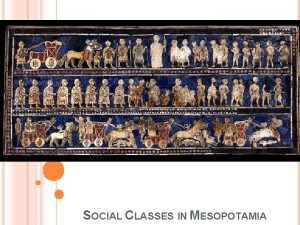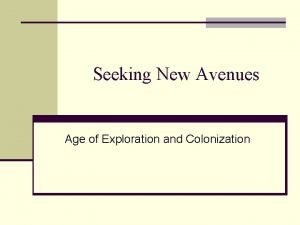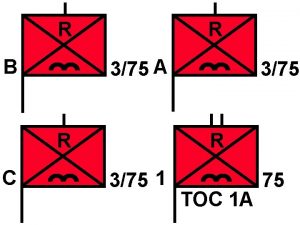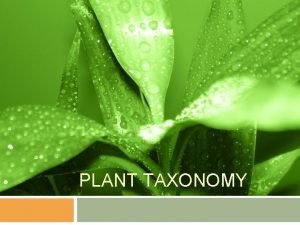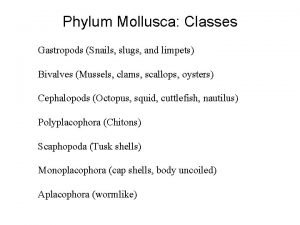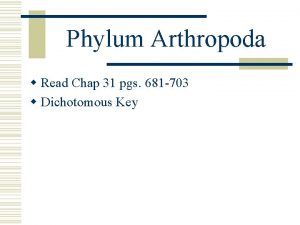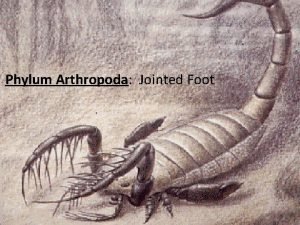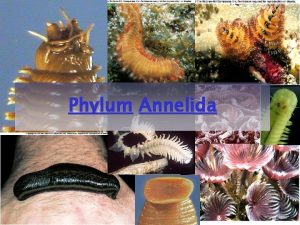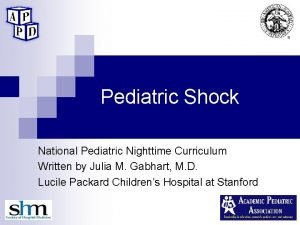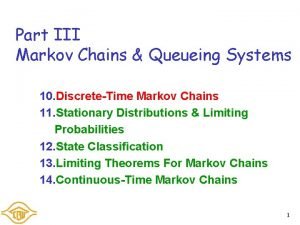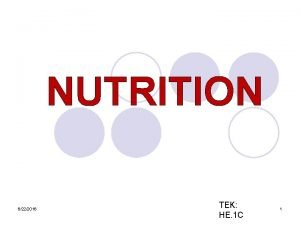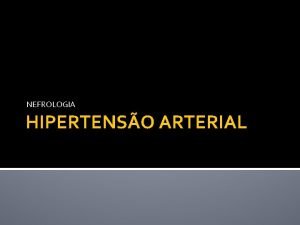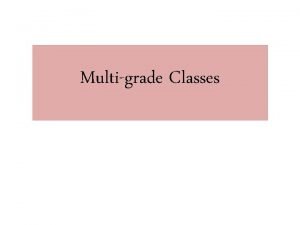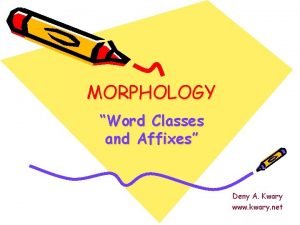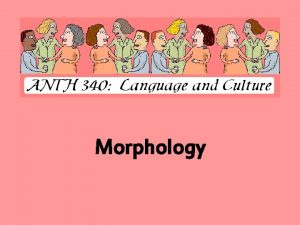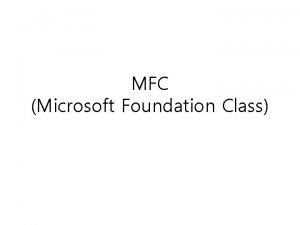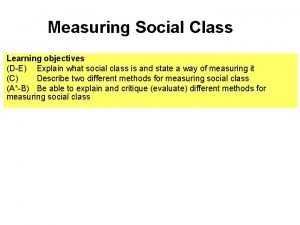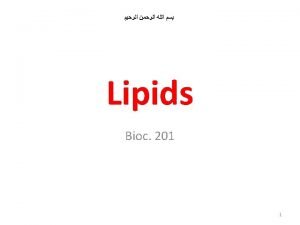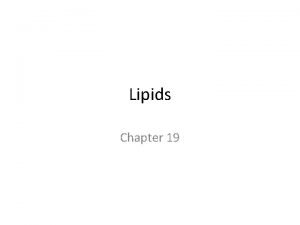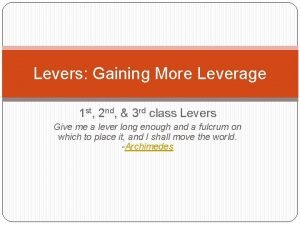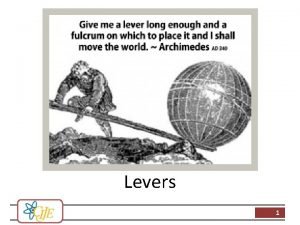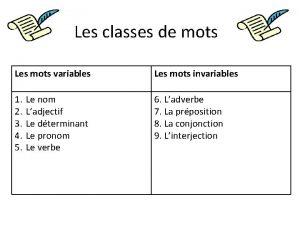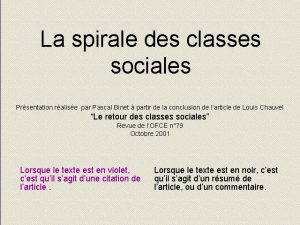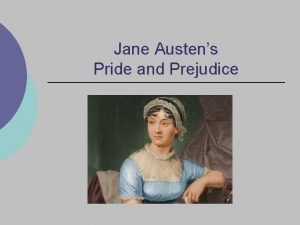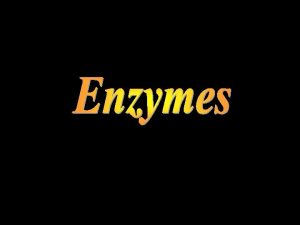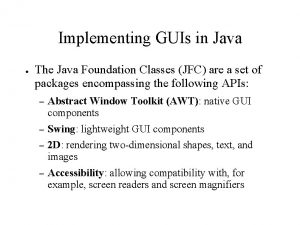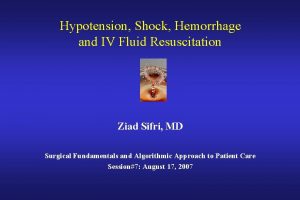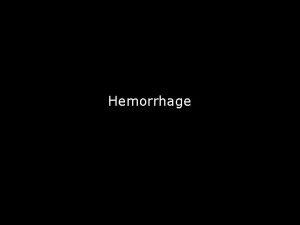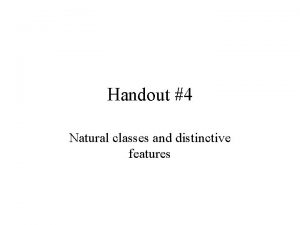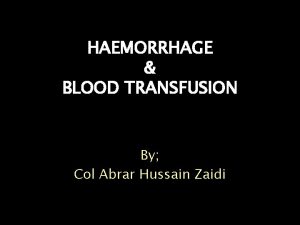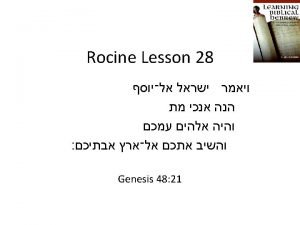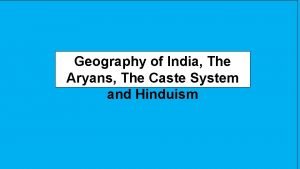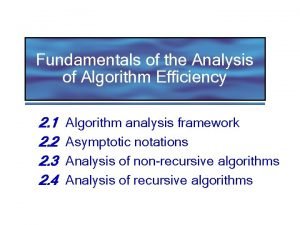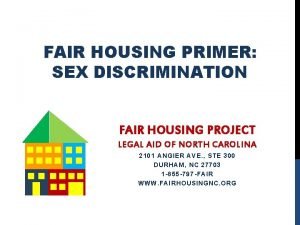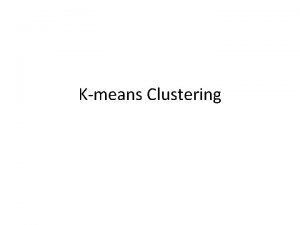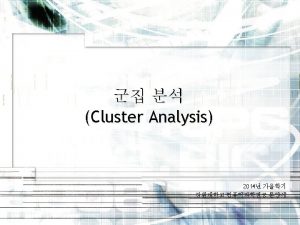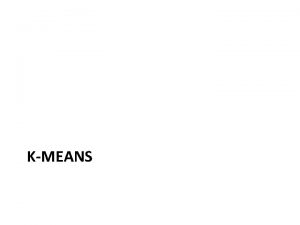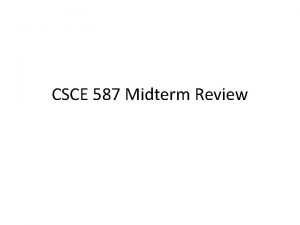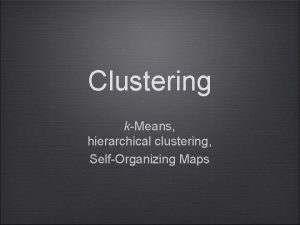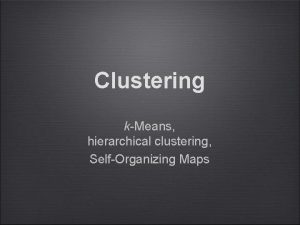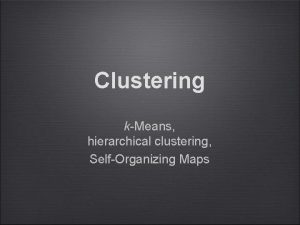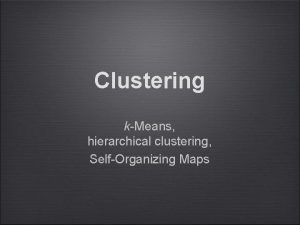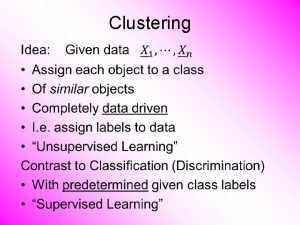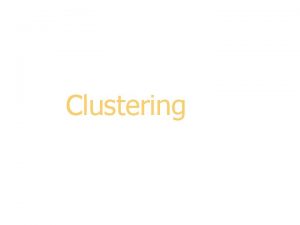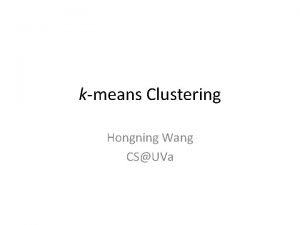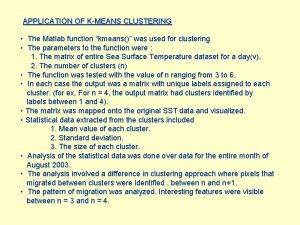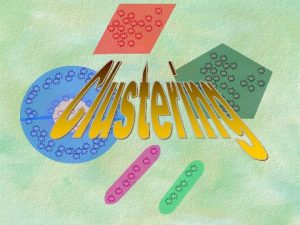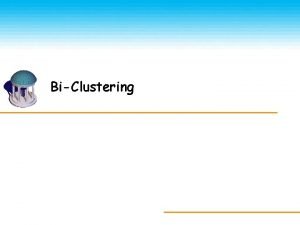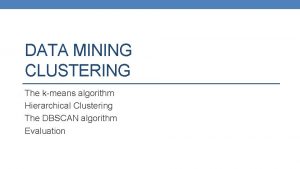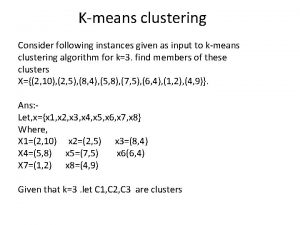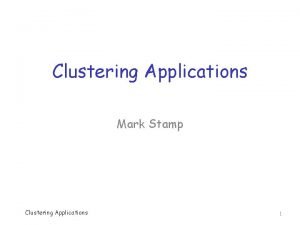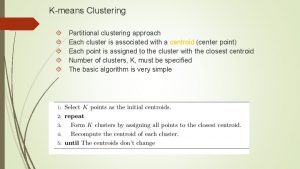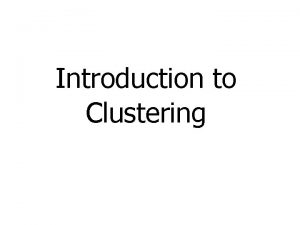Clustering Kmeans Clustering Goal Given data Choose classes


































































































































































- Slides: 162

Clustering •

K-means Clustering Goal: • Given data • Choose classes • To miminize

2 -means Clustering Study CI, using simple 1 -d examples • Varying Standard Deviation • Varying Mean • Varying Proportion

2 -means Clustering

2 -means Clustering Curve Shows CI for Many Reasonable Clusterings

2 -means Clustering •

2 -means Clustering Study CI, using simple 1 -d examples • Effect of a single outlier?

2 -means Clustering

SWISS Score Another Application of CI (Cluster Index) Cabanski et al (2010) Idea: Use CI in bioinformatics to “measure quality of data preprocessing” Philosophy: Clusters Are Scientific Goal So Want to Accentuate Them

SWISS Score Nice Graphical Introduction:

SWISS Score Nice Graphical Introduction:

SWISS Score Revisit Toy Examples (2 -d): Which are “More Clustered? ”

SWISS Score Toy Examples (2 -d): Which are “More Clustered? ”

SWISS Score Avg. Pairwise SWISS – Toy Examples

Hiearchical Clustering Idea: Consider Either: Bottom Up Aggregation: One by One Combine Data Top Down Splitting: All Data in One Cluster & Split Through Entire Data Set, to get Dendogram

Hiearchical Clustering Dendogram Interpretation Branch Length Reflects Cluster Strength

Sig. Clust • Statistical Significance of Clusters • in HDLSS Data • When is a cluster “really there”? Liu et al (2007), Huang et al (2014)

Common Microarray Analytic Approach: Clustering From: Perou et al (2000) d = 1161 genes Zoomed to “relevant” Gene subsets

Interesting Statistical Problem For HDLSS data: n When clusters seem to appear n E. g. found by clustering method n How do we know they are really there? n Question asked by Neil Hayes n Define appropriate statistical significance? n Can we calculate it?

First Approaches: Hypo Testing e. g. Direction, Projection, Permutation Hypothesis test of: Significant difference between sub-populations

Di. Pro. Perm Hypothesis Test Two Examples Which Is “More Distinct”? Visually Better Separation? Thanks to Katie Hoadley

Di. Pro. Perm Hypothesis Test Two Examples Which Is “More Distinct”? Stronger Statistical Significance! Thanks to Katie Hoadley

First Approaches: Hypo Testing e. g. Direction, Projection, Permutation Hypothesis test of: Significant difference between sub-populations n Effective and Accurate n I. e. Sensitive and Specific n There exist several such tests n But critical point is: What result implies about clusters

Clarifying Simple Example Why Population Difference Tests cannot indicate clustering n. Andrew Nobel Observation n. For Gaussian Data (Clearly 1 Cluster!) n. Assign Extreme Labels (e. g. by clustering) n. Subpopulations are signif’ly different

Simple Gaussian Example n Clearly only 1 Cluster in this Example n But Extreme Relabelling looks different n Extreme T-stat strongly significant n Indicates 2 clusters in data

Simple Gaussian Example Results: n Random relabelling T-stat is not significant n But extreme T-stat is strongly significant n This comes from clustering operation n Conclude sub-populations are different n Now see that: Not the same as clusters really there n Need a new approach to study clusters

Statistical Significance of Clusters Basis of Sig. Clust Approach: n What defines: A Single Cluster? n A Gaussian distribution (Sarle & Kou 1993) n So define Sig. Clust test based on: n 2 -means cluster index (measure) as statistic n Gaussian null distribution n Currently compute by simulation n Possible to do this analytically? ? ?

Sig. Clust Statistic – 2 -Means Cluster Index Measure of non-Gaussianity: n 2 -means Cluster Index n Familiar Criterion from k-means Clustering n Within Class Sum of Squared Distances to Class Means n Prefer to divide (normalize) by Overall Sum of Squared Distances to Mean n Puts on scale of proportions

Sig. Clust Statistic – 2 -Means Cluster Index Measure of non-Gaussianity: n 2 -means Cluster Index: Class Index Sets Class Means “Within Class Var’n” / “Total Var’n”

Sig. Clust Gaussian null distribut’n •

Sig. Clust Gaussian null distribut’n •

Sig. Clust Gaussian null distribut’n •

Sig. Clust Gaussian null distribut’n •

Sig. Clust Gaussian null distribut’n •

Sig. Clust Gaussian null distribut’n •

Sig. Clust Gaussian null distribut’n •

Sig. Clust Gaussian null distribut’n •

Sig. Clust Gaussian null distribut’n •

Sig. Clust Gaussian null distribut’n •

Sig. Clust Gaussian null distribut’n •

Sig. Clust Estimation of Background Noise n = 533, d = 9456

Sig. Clust Estimation of Background Noise Hope: Most Entries are “Pure Noise, (Gaussian)”

Sig. Clust Estimation of Background Noise Hope: Most Entries are “Pure Noise, (Gaussian)” A Few (<< ¼) Are Biological Signal – Outliers

Sig. Clust Estimation of Background Noise Hope: Most Entries are “Pure Noise, (Gaussian)” A Few (<< ¼) Are Biological Signal – Outliers How to Check?

Q-Q plots An aside: Fitting probability distributions to data • Does Gaussian distribution “fit”? ? ? • If not, why not? • Fit in some part of the distribution? (e. g. in the middle only? )

Q-Q plots Approaches to: Fitting probability distributions to data • Histograms • Kernel Density Estimates Drawbacks: often not best view (for determining goodness of fit)

Q-Q plots Consider Testbed of 4 Toy Examples: Ø non-Gaussian! Ø non-Gaussian(? ) Ø Gaussian? (Will use these names several times)

Q-Q plots Simple Toy Example, non-Gaussian!

Q-Q plots Simple Toy Example, non-Gaussian(? )

Q-Q plots Simple Toy Example, Gaussian

Q-Q plots Simple Toy Example, Gaussian?

Q-Q plots Notes: • Bimodal see non-Gaussian with histo • Other cases: hard to see • Conclude: Histogram poor at assessing Gauss’ity

Q-Q plots Standard approach to checking Gaussianity • QQ – plots Background: Graphical Goodness of Fit Fisher (1983)

Q-Q plots •

Q-Q plots •

Q-Q plots •

Q-Q plots •

Q-Q plots •

Q-Q plots Illustrative graphic (toy data set):

Q-Q plots Illustrative graphic (toy data set):

Q-Q plots Illustrative graphic (toy data set):

Q-Q plots Empirical Quantiles (sorted data points)

Q-Q plots Corresponding ( matched) Theoretical Quantiles

Q-Q plots •

Q-Q plots Illustrative graphic (toy data set):

Q-Q plots Illustrative graphic (toy data set):

Q-Q plots Illustrative graphic (toy data set):

Q-Q plots Illustrative graphic (toy data set):

Q-Q plots Illustrative graphic (toy data set):

Q-Q plots Illustrative graphic (toy data set): Empirical Qs near Theoretical Qs when Q-Q curve is near 450 line (general use of Q-Q plots)

Alternate Terminology Q-Q Plots = ROC Curves Recall “Receiver Operator Characteristic” Applied to Empirical Distribution vs. Theoretical Distribution

Alternate Terminology Q-Q Plots = ROC Curves Recall “Receiver Operator Characteristic” But Different Goals: Ø Q-Q Plots: Look for “Equality” Ø ROC curves: Look for “Differences”

Alternate Terminology Q-Q Plots = ROC Curves P-P Plot = Curve that Highlights Different Distributional Aspects Statistical Folklore: Q-Q Highlights Tails, So Usually More Useful

Alternate Terminology Q-Q Plots = ROC Curves Related Measures: Precision & Recall

Q-Q plots non-Gaussian! departures from line?

Q-Q plots non-Gaussian! departures from line? • Seems different from line? • 2 modes turn into wiggles? • Less strong feature • Been proposed to study modality

Q-Q plots non-Gaussian (? ) departures from line?

Q-Q plots non-Gaussian (? ) departures from line? • Seems different from line? • Harder to say this time? • What is signal & what is noise? • Need to understand sampling variation

Q-Q plots Gaussian? departures from line?

Q-Q plots Gaussian? departures from line? • Looks much like? • Wiggles all random variation? • But there are n = 10, 000 data points… • How to assess signal & noise? • Need to understand sampling variation

Q-Q plots Need to understand sampling variation • Approach: Q-Q envelope plot – Simulate from Theoretical Dist’n – Samples of same size – About 100 samples gives “good visual impression” – Overlay resulting 100 QQ-curves – To visually convey natural sampling variation

Q-Q plots non-Gaussian! departures from line?

Q-Q plots non-Gaussian! departures from line? • Envelope Plot shows: • Departures are significant • Clear these data are not Gaussian • Q-Q plot gives clear indication

Q-Q plots non-Gaussian (? ) departures from line?

Q-Q plots non-Gaussian (? ) departures from line? • Envelope Plot shows: • Departures are significant • Clear these data are not Gaussian • Recall not so clear from e. g. histogram • Q-Q plot gives clear indication • Envelope plot reflects sampling variation

Q-Q plots Gaussian? departures from line?

Q-Q plots Gaussian? departures from line? • Harder to see • But clearly there • Conclude non-Gaussian • Really needed n = 10, 000 data points… (why bigger sample size was used) • Envelope plot reflects sampling variation

Q-Q plots What were these distributions? • Non-Gaussian! – 0. 5 N(-1. 5, 0. 752) + 0. 5 N(1. 5, 0. 752) • Non-Gaussian (? ) – 0. 4 N(0, 1) + 0. 3 N(0, 0. 52) + 0. 3 N(0, 0. 252) • Gaussian? – 0. 7 N(0, 1) + 0. 3 N(0, 0. 52)

Q-Q plots Non-Gaussian!. 5 N(-1. 5, 0. 752) + 0. 5 N(1. 5, 0. 752)

Q-Q plots Non-Gaussian (? ) 0. 4 N(0, 1) + 0. 3 N(0, 0. 52) + 0. 3 N(0, 0. 252)

Q-Q plots Gaussian

Q-Q plots Gaussian? 0. 7 N(0, 1) + 0. 3 N(0, 0. 52)

Q-Q plots •

Q-Q plots •

Q-Q plots Variations on Q-Q Plots: • Can replace Gaussian with other dist’ns • Can compare 2 theoretical distn’s • Can compare 2 empirical distn’s (i. e. 2 sample version of Q-Q Plot) ( = ROC curve)

Sig. Clust Estimation of Background Noise n = 533, d = 9456

Sig. Clust Estimation of Background Noise • Overall distribution has strong kurtosis • Shown by height of kde relative to MAD based Gaussian fit • Mean and Median both ~ 0 • SD ~ 1, driven by few large values • MAD ~ 0. 7, driven by bulk of data

Sig. Clust Estimation of Background Noise • Central part of distribution “seems to look Gaussian” • But recall density does not provide great diagnosis of Gaussianity • Better to look at Q-Q plot

Sig. Clust Estimation of Background Noise

Sig. Clust Estimation of Background Noise • Distribution clearly not Gaussian • Except near the middle • Q-Q curve is very linear there (closely follows 45 o line) • Suggests Gaussian approx. is good there • And that MAD scale estimate is good (Always a good idea to do such diagnostics)

Sig. Clust Estimation of Background Noise Now Check Effect of Using SD, not MAD

Sig. Clust Estimation of Background Noise •

Sig. Clust Gaussian null distribut’n •

Sig. Clust Estimation of Eigenval’s

Sig. Clust Estimation of Eigenval’s •

Sig. Clust Estimation of Eigenval’s n Do we need the factor model? n Explore this with another data set (with fewer genes) n This time: n n = 315 cases n d = 306 genes

Sig. Clust Estimation of Eigenval’s

Sig. Clust Estimation of Eigenval’s •

Sig. Clust Gaussian null distribution - Simulation •

Sig. Clust Gaussian null distribution - Simulation Then compare data CI, With simulated null population CIs • Spirit similar to Di. Pro. Perm • But now significance happens for smaller values of CI

An example (details to follow) P-val = 0. 0045

Sig. Clust Modalities Two major applications: I. Test significance of given clusterings (e. g. for those found in heat map) (Use given class labels) II. Test if known cluster can be further split (Use 2 -means class labels)

Sig. Clust Real Data Results Analyze Perou 500 breast cancer data (large cross study combined data set) Current folklore: 5 classes § Luminal A § Luminal B § Normal § Her 2 § Basal

Perou 500 PCA View – real clusters? ? ?

Perou 500 DWD Dir’ns View – real clusters? ? ?

Perou 500 – Fundamental Question Are Luminal A & Luminal B really distinct clusters? Famous for Far Different Survivability

Sig. Clust Results for Luminal A vs. Luminal B P-val = 0. 0045

Sig. Clust Results for Luminal A vs. Luminal B Get p-values from: § Empirical Quantile § From simulated sample CIs § Fit Gaussian Quantile § Don’t “believe these” § But useful for comparison § Especially when Empirical Quantile = 0 Note: Currently Replaced by “Z-Scores”

Sig. Clust Results for Luminal A vs. Luminal B I. Test significance of given clusterings • Empirical p-val = 0 – Definitely 2 clusters • Gaussian fit p-val = 0. 0045 – same strong evidence • Conclude these really are two clusters

Sig. Clust Results for Luminal A vs. Luminal B II. Test if known cluster can be further split • Empirical p-val = 0 – definitely 2 clusters • Gaussian fit p-val = 10 -10 – Stronger evidence than above – Such comparison is value of Gaussian fit – Makes sense (since CI is min possible) • Conclude these really are two clusters

Sig. Clust Real Data Results Summary of Perou 500 Sig. Clust Results: q Lum & Norm vs. Her 2 & Basal, p-val = 10 -19 q Luminal A vs. B, p-val = 0. 0045 q Her 2 vs. Basal, p-val = 10 -10 q Split Luminal A, p-val = 10 -7 q Split Luminal B, p-val = 0. 058 q Split Her 2, p-val = 0. 10 q Split Basal, p-val = 0. 005

Sig. Clust Real Data Results Summary of Perou 500 Sig. Clust Results: • All previous splits were real • Most not able to split further • Exception is Basal, already known • Chuck Perou has good intuition! (insight about signal vs. noise) • How good are others? ? ?

Sig. Clust Real Data Results Experience with Other Data Sets: Similar q. Smaller data sets: less power q. Gene filtering: more power q. Lung Cancer: more distinct clusters

Sig. Clust Real Data Results Some Personal Observations q Experienced Analysts Impressively Good q Sig. Clust can save them time q Sig. Clust can help them with skeptics q Sig. Clust essential for non-experts

Sig. Clust Overview n Works Well When Factor Part Not Used

Sig. Clust Overview n Works Well When Factor Part Not Used n Sample Eigenvalues Always Valid n But Can be Too Conservative

Sig. Clust Overview n Works Well When Factor Part Not Used n Sample Eigenvalues Always Valid n But Can be Too Conservative n Above Factor Threshold Anti-Conservative

Sig. Clust Overview n Works Well When Factor Part Not Used n Sample Eigenvalues Always Valid n But Can be Too Conservative n Above Factor Threshold Anti-Conservative n Problem Fixed by Soft Thresholding (Huang et al, 2014)

Sig. Clust Open Problems n Improved Eigenvalue Estimation (Random Matrix Theory) n More attention to Local Minima in 2 means Clustering n Theoretical Null Distributions n Inference for k > 2 means Clustering n Multiple Comparison Issues

Big Picture •

Shapes As Data Objects Several Different Notions of Shape Oldest and Best Known (in Statistics): Landmark Based

Shapes As Data Objects •

Shapes As Data Objects Landmark Based Shape Analysis: v Kendall (et al 1999) v Bookstein (1991) v Dryden & Mardia (1998, revision coming) Recommended as Most Accessible

Landmark Based Shape Analysis UNC, Stat & OR Start by Representing Shapes 134

Landmark Based Shape Analysis UNC, Stat & OR Start by Representing Shapes by Landmarks (points in R 2 or R 3) 135

Landmark Based Shape Analysis UNC, Stat & OR Start by Representing Shapes by Landmarks (points in R 2 or R 3) 136

Landmark Based Shape Analysis UNC, Stat & OR Clearly different shapes: 137

Landmark Based Shape Analysis UNC, Stat & OR Clearly different shapes: But what about: ? 138

Landmark Based Shape Analysis UNC, Stat & OR Clearly different shapes: But what about: ? (just translation and rotation of, but different points in R 6) 139

Landmark Based Shape Analysis UNC, Stat & OR Note: Shape should be same over different: • Translations 140

Landmark Based Shape Analysis UNC, Stat & OR Note: Shape should be same over different: • Translations • Rotations 141

Landmark Based Shape Analysis UNC, Stat & OR Note: Shape should be same over different: • Translations • Rotations • Scalings 142

Landmark Based Shape Analysis UNC, Stat & OR Approach: Identify objects that are: • Translations • Rotations • Scalings of each other 143

Landmark Based Shape Analysis UNC, Stat & OR Approach: Identify objects that are: • Translations • Rotations • Scalings of each other Mathematics: Equivalence Relation 144

Equivalence Relations Useful Mathematical Device • Weaker generalization of “=“ for a set • Main consequence: – Partitions Set Into Equivalence Classes – For “=“, Equivalence Classes Are Singletons

Equivalence Relations Common Example: Modulo Arithmetic (E. g. Clock Arithmetic, mod 12) 3 hours after 11: 00 is 2: 00 …

Equivalence Relations •

Equivalence Relations •

Equivalence Relations •

Equivalence Relations •

Equivalence Relations •

Equivalence Relations •

Equivalence Relations •

Equivalence Relations •

Landmark Based Shape Analysis UNC, Stat & OR Approach: Identify objects that are: • Translations • Rotations • Scalings of each other Mathematics: Results in: Equivalence Relation Equivalence Classes (orbits) Which become the Data Objects 155

Landmark Based Shape Analysis UNC, Stat & OR Equivalence Classes become Data Objects Mathematics: Called “Quotient Space” Intuitive Representation: Manifold (curved surface) , , , 156

Landmark Based Shape Analysis UNC, Stat & OR Triangle Shape Space: Represent as Sphere , , , 157

Landmark Based Shape Analysis UNC, Stat & OR Triangle Shape Space: Represent as Sphere: R 6 R 4 translation , , , 158

Landmark Based Shape Analysis UNC, Stat & OR Triangle Shape Space: Represent as Sphere: R 6 R 4 R 3 rotation , , , 159

Landmark Based Shape Analysis UNC, Stat & OR Triangle Shape Space: Represent as Sphere: R 6 R 4 R 3 scaling (thanks to Wikipedia) , , , 160

Shapes As Data Objects Common Property of Shape Data Objects: Natural Feature Space is Curved I. e. a Manifold (from Differential Geometry)

Participant Presentation Rui Wang ? ? ?
 Som vs kmeans
Som vs kmeans Javascript kmeans
Javascript kmeans Patrick mackey
Patrick mackey Flat vs hierarchical clustering
Flat vs hierarchical clustering L
L Rumus euclidean
Rumus euclidean Muito classe e subclasse
Muito classe e subclasse Pre ap classes vs regular classes
Pre ap classes vs regular classes Choose correct item
Choose correct item Choosethecorrectanswer
Choosethecorrectanswer Clustering by passing messages between data points
Clustering by passing messages between data points Classification and clustering in data mining
Classification and clustering in data mining Clustering non numeric data
Clustering non numeric data Find centroid of tree
Find centroid of tree A framework for clustering evolving data streams
A framework for clustering evolving data streams Data mining clustering
Data mining clustering K-means clustering algorithm in data mining
K-means clustering algorithm in data mining Organizes data into categories called classes
Organizes data into categories called classes Data science school edison
Data science school edison Clustering vs classification
Clustering vs classification The trajectory
The trajectory Graclus
Graclus Hydrophobic clustering
Hydrophobic clustering Cmu machine learning
Cmu machine learning Brown clustering
Brown clustering Clustering what is
Clustering what is Tableau clustering algorithm
Tableau clustering algorithm Spectral clustering
Spectral clustering Hcs clustering algorithm
Hcs clustering algorithm R&cm
R&cm Dbscan hierarchical clustering
Dbscan hierarchical clustering Cure: an efficient clustering algorithm for large databases
Cure: an efficient clustering algorithm for large databases Bi clustering
Bi clustering Spectral clustering
Spectral clustering Clustering vs classification
Clustering vs classification Clustering ideas
Clustering ideas Point assignment clustering
Point assignment clustering Clustering vs classification
Clustering vs classification Birch clustering
Birch clustering Global clustering coefficient
Global clustering coefficient Graph degree distribution
Graph degree distribution Jarvis patrick clustering
Jarvis patrick clustering Billenko
Billenko Clustering slides
Clustering slides Clustering in business intelligence
Clustering in business intelligence Chameleon clustering
Chameleon clustering Bayesian hierarchical clustering
Bayesian hierarchical clustering Global clustering coefficient
Global clustering coefficient Divisive clustering
Divisive clustering Carlo marks
Carlo marks Mahalanobisova vzdálenost
Mahalanobisova vzdálenost Thematic clustering
Thematic clustering Fuzzy clustering tutorial
Fuzzy clustering tutorial Statquest clustering
Statquest clustering Prewrite definition
Prewrite definition Manifold clustering
Manifold clustering Rank order clustering algorithm
Rank order clustering algorithm Flat clustering
Flat clustering Clustering slides
Clustering slides Grid-based clustering
Grid-based clustering Bfr clustering
Bfr clustering What is clustering in writing
What is clustering in writing Hierarchical clustering spss
Hierarchical clustering spss Birch clustering
Birch clustering Text clustering
Text clustering Sql server geo clustering
Sql server geo clustering Front end estimation decimals
Front end estimation decimals Parallel social media
Parallel social media Rock clustering algorithm
Rock clustering algorithm Real application clustering
Real application clustering K means clustering
K means clustering Hierarchical clustering demo
Hierarchical clustering demo Fuzzy clustering tutorial
Fuzzy clustering tutorial Flat clustering
Flat clustering Motivation definition wikipedia
Motivation definition wikipedia Clustering in bioinformatics
Clustering in bioinformatics Jvm clustering
Jvm clustering Agglomerative clustering
Agglomerative clustering Papercut clustering
Papercut clustering Wsfc sql
Wsfc sql Tanka poem
Tanka poem Clustering coefficient
Clustering coefficient Ncut
Ncut K medoid clustering
K medoid clustering Growing network
Growing network Disadvantages of k means clustering
Disadvantages of k means clustering Hierarchical clustering
Hierarchical clustering Complete link clustering
Complete link clustering Clustering slides
Clustering slides Fuzzy k means
Fuzzy k means Document clustering
Document clustering Jeus session clustering
Jeus session clustering Clustering outline
Clustering outline Lsh clustering
Lsh clustering Unsupervised hierarchical clustering
Unsupervised hierarchical clustering Primary clustering
Primary clustering Clustroid
Clustroid Cisco collaboration edge
Cisco collaboration edge What are the three classes of yeast bread?
What are the three classes of yeast bread? Worm characteristics
Worm characteristics Jmu ap scores
Jmu ap scores Ivc summer classes for high school students
Ivc summer classes for high school students Stream classes in c++
Stream classes in c++ Ancient china hierarchy pyramid
Ancient china hierarchy pyramid Titanic social class
Titanic social class Song dynasty social structure
Song dynasty social structure Federally protected classes
Federally protected classes Canterbury tales social classes chart
Canterbury tales social classes chart Aztec hierchy
Aztec hierchy Classes of supply army
Classes of supply army Teaching multilevel esl classes
Teaching multilevel esl classes Steroid hormones action
Steroid hormones action Spanish social classes
Spanish social classes Social class mesopotamia
Social class mesopotamia Social classes in ancient japan
Social classes in ancient japan Spanish social classes
Spanish social classes Military classes of supply
Military classes of supply Ship alarm signals
Ship alarm signals Class k fire
Class k fire Order plants
Order plants Classes of phylum mollusca
Classes of phylum mollusca Dichotomous key
Dichotomous key Daphnia
Daphnia Jointed foot
Jointed foot Oligochaeta
Oligochaeta Phonetics vs phonology
Phonetics vs phonology Aliping namamahay
Aliping namamahay Aliping namamahay
Aliping namamahay Compensated shock
Compensated shock Find the stationary distribution
Find the stationary distribution How many classes of nutrients are there
How many classes of nutrients are there Six classes of food
Six classes of food Classes antihipertensivos
Classes antihipertensivos Stigma associated with failure and repetition is removed
Stigma associated with failure and repetition is removed Examples of words with 5 morphemes
Examples of words with 5 morphemes Morpology
Morpology Todas as dez classes gramaticais
Todas as dez classes gramaticais Mfc 표 만들기
Mfc 표 만들기 5 social class
5 social class Marquette nfp training
Marquette nfp training Classes of lipids
Classes of lipids Are lipids energy storage
Are lipids energy storage First class lever examples
First class lever examples A structure
A structure Les mots variables et les mots invariables
Les mots variables et les mots invariables La spirale des classes sociales
La spirale des classes sociales Regency era social classes
Regency era social classes Enzyme classes
Enzyme classes List button
List button Classes of shock
Classes of shock Lausd approved salary point classes
Lausd approved salary point classes Reactionary hemorrhage definition
Reactionary hemorrhage definition Manner features
Manner features Types of haemorrhage
Types of haemorrhage Hollow classes
Hollow classes India social classes
India social classes Transição demográfica
Transição demográfica A ____ is the symbol for a type c fire extinguisher.
A ____ is the symbol for a type c fire extinguisher. Best case efficiency
Best case efficiency 5 classes of fire
5 classes of fire Sistema circulatório moluscos
Sistema circulatório moluscos Federally protected classes
Federally protected classes Fhc food handler classes
Fhc food handler classes
